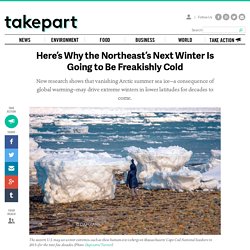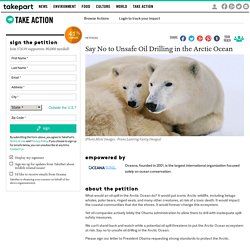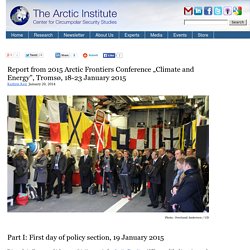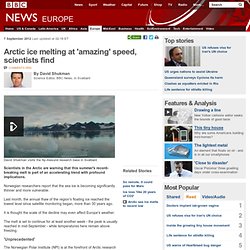

Takepart. When it comes to the global climate, what happens in the Arctic does not stay in the Arctic.

The latest proof comes in new research connecting the unusually brutal winter of 2014–15 along the East Coast of North America to rapidly vanishing summer sea ice on the western side of the Arctic Ocean. The new study, published Monday in the journal Nature Geoscience, advances a growing body of science demonstrating that these record-breaking extremes have not been a pause in the advance of human-driven climate change but a result of it. The findings suggest that as the Arctic continues to thaw, the mercury will crash over many winters to come. Temperatures reached record lows across the Northeastern United States last winter, with towns and cities in states from Maine to Maryland registering their coldest temperature averages from January to March.
Boston’s total of 108.6 inches of snow for the season broke a 17-year record and crippled the city. Say No to Unsafe Oil Drilling in the Arctic Ocean. What would an oil spill in the Arctic Ocean do?

It would put iconic Arctic wildlife, including beluga whales, polar bears, ringed seals, and many other creatures, at risk of a toxic death. It would impact the coastal communities that dot the shores. It would forever change this ecosystem. Yet oil companies actively lobby the Obama administration to allow them to drill with inadequate spill-safety measures. We can’t stand back and watch while a potential oil spill threatens to put the Arctic Ocean ecosystem at risk. Please sign our letter to President Obama requesting strong standards to protect the Arctic. To: President Barack Obama. The art of imitating the Arctic. Location is everything for ‘Fortitude’.

Both in reality and in fiction, there are plenty of important details about the Arctic location of the 12-episode thriller, scheduled to begin airing on Sky, a British television channel, on January 29, and on Pivot, an American cable channel, on the same day. To start with is the fact that the real-life location of Fortitude, the Arctic settlement where the series takes place, is not where the producers would have you believe. Though never stated in the series, Fortitude is Longyearbyen, Svalbard, admits Petur Siggurdsson, a production manager with Pegasus, a production company, and who helped find the setting for the film. But while the clues to Fortitude’s inspiration are obvious (it is the world’s northernmost settlement; it is located on an island; it is populated by foreign scientists; polar bears outnumber people, its police officers wear Norwegian politi uniforms) the clues to its real life location may be harder to spot.
The Arctic Institute - Center for Circumpolar Security Studies. Report from 2015 Arctic Frontiers Conference „Climate and Energy”, Tromsø, 18-23 January 2015 Photo: Overland Andersen / UD Part I: First day of policy section, 19 January 2015 It is early in the year, which means it is time again for Arctic Frontiers (AF), one of the biggest annual conferences on and in the Arctic.

This year, around 1400 participants coming from 37 countries gather in the north Norwegian town of Tromsø. As during the last conferences, the week-long AF starts off with a two day policy section with high-level speakers and discussion rounds, followed by a three-day science section with Arctic scientists presenting their latest finding in oral and poster presentations. Arctic climate change – global implications,Ecological winners and losers in future Arctic marine ecosystemsThe Arctic's role in the global energy supply and security. As another argument against long-term Norwegian energy engagement in the Arctic, Mr. Overall, Mr. NWS WPC sur Twitter : "Great Falls, MT went from 54 F to 22 F in 1 hour. Now at 1 F! #arcticfront #mtwx #winteriscoming...
Is Annual Arctic Sea Ice On Decent Track For A Change? North Sea Oil Leaks Expose Industry’s Inability to Safely Drill in Arctic. TckTckTck Greenpeace has warned about new figures showing Britain’s offshore rigs and platforms have leaked oil or other chemicals into the North Sea 55 times over the past month should act as a “reality check” for an industry aiming to drill in the Arctic.

The latest figures, released by the Department for Energy and Climate Change, challenge claims that the industry has a strong a effective safety and environmental recorded. Facilities operated by Shell, BP and BG Group were all offenders. Greenpeace say the figures are alarming, particularly when you consider that the industry is trying to persuade the world it should be allowed to drill in the pristine but harsh environments of the Arctic.
Greenpeace senior climate adviser Charlie Kronick said: This will do little to increase public trust in their ability to drill in the Arctic without damaging this incredibly beautiful and fragile corner of our planet. E. Visit EcoWatch’s OFFSHORE OIL DRILLING page for more related news on this topic. Arctic ice melting at 'amazing' speed, scientists find. 7 September 2012Last updated at 02:18 ET By David Shukman Science Editor, BBC News, in Svalbard David Shukman visits the Ny-Alesund research base in Svalbard Scientists in the Arctic are warning that this summer's record-breaking melt is part of an accelerating trend with profound implications.

Norwegian researchers report that the sea ice is becoming significantly thinner and more vulnerable. Last month, the annual thaw of the region's floating ice reached the lowest level since satellite monitoring began, more than 30 years ago. It is thought the scale of the decline may even affect Europe's weather. The melt is set to continue for at least another week - the peak is usually reached in mid-September - while temperatures here remain above freezing. 'Unprecedented'